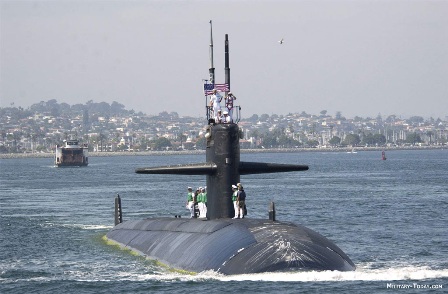Los Angeles-class (SSN-688)
Summary
| Origin country | 🇺🇸 United States |
| Category | Submarine |
| Subtype | Nuclear attack submarine |
| Manufacturer | Newport News Shipbuilding, General Dynamics Electric Boat |
| Year commissioned | 1976 |
| Approx. unit cost | $1670 million |
| Units |
SSN-722 USS Key West SSN-725 USS Helena SSN-750 USS Newport News SSN-751 USS San Juan SSN-752 USS Pasadena SSN-753 USS Albany SSN-754 USS Topeka SSN-756 USS Scranton SSN-757 USS Alexandria SSN-758 USS Asheville SSN-759 USS Jefferson City SSN-760 USS Annapolis SSN-761 USS Springfield SSN-762 USS Columbus SSN-763 USS Santa Fe SSN-764 USS Boise SSN-765 USS Montpelier SSN-766 USS Charlotte SSN-767 USS Hampton SSN-768 USS Hartford SSN-769 USS Toledo SSN-770 USS Tucson SSN-771 USS Columbia SSN-772 USS Greeneville SSN-773 USS Cheyenne |
| Current operators | 🇺🇸 United States |
Description
The Los Angeles-class submarines are a series of nuclear-powered fast attack submarines (SSN) which form the backbone of the United States Navy's submarine force. Commissioned between the 1970s and 1990s, these vessels are named after U.S. cities and are primarily tasked with seeking and destroying enemy submarines and surface ships, intelligence gathering, and supporting carrier battle groups.
Developed during the Cold War, the Los Angeles class was designed to counter the then-Soviet Navy. The design reflects an emphasis on underwater speed, agility, and firepower. The hydrodynamic hull enables these submarines to operate quietly, minimizing detectability. They are also equipped with sophisticated sonar systems and anechoic tiles that absorb sound waves, further reducing their acoustic signature.
In terms of armament, Los Angeles-class submarines carry a formidable array of weapons. They are equipped with four 21-inch torpedo tubes capable of launching Mark 48 torpedoes, Harpoon anti-ship missiles, and Tomahawk cruise missiles. The later units of the class were also designed with vertical launch systems for Tomahawk missiles, increasing their long-range strike capabilities. Their weapons systems are continually updated to keep pace with advancements in technology and evolving threats.
The operational history of the Los Angeles class is marked by a transition from Cold War deterrence to adapting to post-Cold War challenges. They have been involved in various significant operations and have frequently been deployed for surveillance and reconnaissance missions, supporting national security objectives. These submarines have also played crucial roles in conflict zones, leveraging their Tomahawk missiles for precision strikes.
Operated exclusively by the United States, the Los Angeles class are still active, but progressively make way for the more advanced Virginia and upcoming Columbia classes.
Technical specifications
| Displacement | 6080 tons |
| Displacement submerged | 6927 tons |
| Range | Unlimited, except by food supplies |
| Endurance | 90 days |
| Crew | 129 members |
| Width | 10.0 m (32.8 ft) |
| Length | 110.0 m (360.9 ft) |
| Max. depth | 450 m (1476.4 ft) |
| Propulsion | 1 General Electric S 6G reactor with a power of 35,000 hp - 1 propeller |
| Armament | 4 533mm TLTs (26 Mk.48 / TASM / SLMM / Sub-Harpoon) |
| Maximum speed | 20 knots |
| Max. speed submerged | 32 knots |

